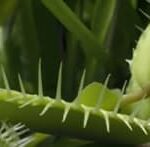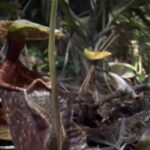As an Amazon Associate, this site earns commissions from qualifying purchases. For more details, click here.
Pitcher plants come in different shapes, colors and sizes, but they all share the need for light. However some species need more than others, so you have to be careful how much of it, natural or artificial, you provide. A lot of light is good but too much can be unhealthy as well. This article walks through the fundamentals of pitcher plant light.
Pitcher plants require at least 6-8 hours of light though some species may need more. Nepenthes pitcher plants thrive in partial to full light while sarracenia always requires full, direct light. Grow lights can also be used for indoor cultivation.
When people talk about pitcher plants they generally refer to nepenthes or sarracenia. They have different light requirements so keep that in mind.
Nepenthes Pitcher Plant Light Requirements
Nepenthes are tropical plants and need partial to full light. Lowland nepenthes plants will thrive in bright sunlight whereas highland nepenthes prefer partial shade.
- Examples of lowland nepenthes are N. Rafflesiana, N. Ventricosa, N. Truncata and N. Gracilis.
- Examples of highland nepenthes are N. Maxima, N. Sanguinea, N. Fusca and N. Alata.
Lowland nepenthes naturally grow in fields and forests where they are exposed to mostly direct sunlight. Highland nepenthes are found in rainy, humid mountaintops.
Plants need light for many reasons, but you have to make sure it is the right amount. The easiest nepenthes to care for is the one that grows naturally in your location. If you have a specific nepenthes plant in mind, you have to reproduce its natural environment – including light – as accurately as possible.
Can Nepenthes Get Too Much Light? These plants prefer partial or direct lighting but too much is harmful. If the plant is under partial cover, it can handle intense light at high temperature. But without any shade its leaves could burn. Cool temperature helps the plant withstand direct sunlight, but generally it is best to stick with the mostly partial light with a bit of full light approach.
Natural vs. Grow Lights
Nepenthes will do fine with either one. If you live in a warm region, natural light should be enough. If the plant is indoors, you can just leave it on a windowsill and it will get all the required light. For outdoors it is the same. You just have to make sure the temperature does not get too hot.
Use artificial or grow lights if sunlight is in inadequate. There are plenty of indoor lighting available and one that we like are LBW Grow Lights. Nepenthes thrives in them as well as other carnivorous plants.
Lowland pitcher plants benefit from grow lights because they need more than their highland counterparts. But even highland pitcher plants will need artificial sources if sunlight is limited. This direct affects how long pitcher plants can live so use indoor lighting when necessary.
Soil, Pot and Light. Keep the soil moist at all times. Water as often as necessary especially during summer. Warm, intense light dries up soil quickly so regular watering is required. Pots can be 4-10 inches depending on the plant size.
Where to Grow Nepenthes
Lowland nepenthes will grow anywhere in partial to full light as long as the temperature is under 95 F (35 C). Highland nepenthes should be partly covered but make sure it still gets sunlight.
Nepenthes can grow in a terrarium, greenhouse, indoors or outdoors as long as receives the proper amount of light. This is why it helps if the plant is native to your location because it makes setup easier.
If the plant is in its native region you can leave it outdoors. Otherwise you should keep it in a greenhouse or indoors so the temperature and humidity are constant.
Temperature and Humidity
The ideal temperature for lowland nepenthes pitcher plants is 75-80 F (24-26 C) and for highland variants it is 65-95 F (18-35 C). The optimum humidity rate is 50-60% for most species.
No matter where you grow nepenthes you have to keep the temperature and humidity as close to this range as possible. Terrariums and greenhouses are effective options for indoor cultivation. But do make sure you open it every now and then so fresh air gets in.
Outdoors, the temperature, humidity and sunlight go hand in hand. If you want your lowland nepenthes to get more light, moving it outdoors is a good idea. You can leave the plant there as long as the temperature and humidity are acceptable.
Dormancy. These are tropical plants and do not require dormancy. Their environment should be consistent all year long. If your nepenthes is outdoors, move it inside if you get prolonged winter seasons.
Sarracenia Pitcher Plant Light Requirements
Sarracenia plants need 6-12 hours of full, direct light. Natural sunlight is recommended but artificial lighting will work too. What is important is these pitcher plants must never be placed under shade.
Sarracenia is similar to lowland nepenthes in that they both require a lot of light. Sarracenia can also handle high temperature, though it prefers a humid environment. Unlike nepenthes however, sarracenia plants go dormant in winter.
Natural vs. Artificial Light. Most sarracenia growers will tell you natural light is better and it is. But indoor lighting can be as effective if done right.
T5 fluorescent lights are suitable not just for sarracenia but other indoor plants. In the past LED lights were not considered sufficient, but high quality lights are now available. You could use GooingTop LED Grow Lights and get good results.
Ideally, grow light should be used to supplement sunlight. Your objective is to recreate its natural habitat and the sun obviously plays a big part. If you live in a warm, sunny region with 6-8 hours of sunlight, your sarracenia will thrive.
Where to Grow Sarracenia
Lack of light weakens sarracenia, so look for the sunniest location possible. They need more light than nepenthes and other carnivorous plants so location is even more important.
If your pitcher plant is indoors, place it on a windowsill. Do this only if there is enough light coming through. Move the plant outdoors or install a fluorescent bulb to increase lighting.
Sarracenia pitcher plants have a hard time growing in terrariums due to lack of light. Some species can reach up to 3 and half feet so space could be an issue too. A non-heated greenhouse is a good choice or even a mini bog. You can use any pot size as these pitcher plants adapt well to limited spaces.
Light, Soil and Pot. Because sarracenia requires full light, you have to keep an eye on the soil. Like nepenthes, sarracenia soil must always be moist, not soggy. Under direct sunlight it could dry up very quickly.
Here is a simple way to check if soil moisture is sufficient. Press two fingers in the soil. If water comes out then it is soggy. If the dirt does not stick to your fingers, the soil is too dry. But if the moss sticks to your hand without pulling up water, the moisture level is right. This applies to nepenthes plants too.
Dormancy, Temperature and Humidity
Sarracenia naturally thrive in temperature up to 95 F (35 C). A humidity of 60% is great but lower levels will not hurt it.
These plants naturally go dormant when the temperature drops below 32 F (0 C) so keep that in mind. If the plant is indoors, you have to move it to an unheated location. Leave the plant there for 3-4 months until it starts to reemerge.
As your sarracenia comes out of dormancy, slowly reintroduce it to light. Start with a low level artificial bulb and increase it slowly. Full natural light is preferable and the more hours the better.
Can Sarracenia Have Too Much Light?
This is unlikely. These pitcher plants normally grow in 85-90 F degrees with full sunlight. Unless your home gets exposed to higher temperature your sarracenia will keep growing.
The biggest threat for these pitcher plants is the lack of light. Because they can survive in high temperature you can leave it outdoors and not worry too much. Unless the thermometer climbs up over a 100 degrees the plant will flourish.
Nepenthes and sarracenia are low maintenance carnivorous plants. Once you have everything set up properly that is. Given how important light is, you should go over the prospective locations thoroughly. In the end you will be thankful you did.

My fascination with carnivorous plants began many, many years ago with Venus Fly Traps. Now I am more than happy to impart what I know with other enthusiasts and those who are curious about meat eating plants.



